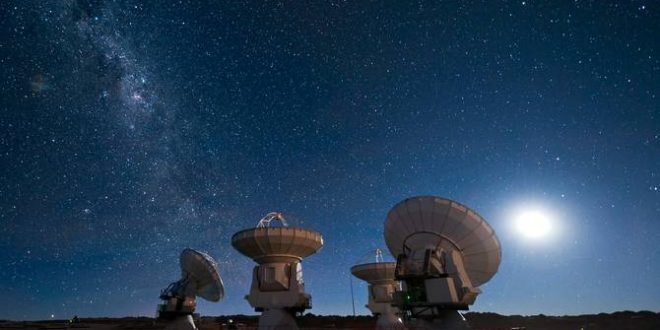Something peculiar is going on in deep space. A new trio of Fast Radio Bursts (FRBs), unimaginably powerful releases of radio waves with no discernible origin, have been detected by an Australian observatory.
Manisha Caleb, a PhD candidate at Australian National University, Swinburne University of Technology and the ARC Centre of Excellence for All-sky Astrophysics (CAASTRO), has confirmed that the mystery bursts of radio waves that astronomers have hunted for ten years really do come from outer space.
Ms Caleb worked with Swinburne and University of Sydney colleagues to detect three of these Fast Radio Bursts (FRBs) with the Molonglo radio telescope 40 km from Canberra.
Discovered almost 10 years ago at CSIRO’s Parkes radio telescope, Fast Radio Bursts are millisecond-duration intense pulses of radio light that appear to be coming from vast distances. They are about a billion times more luminous than anything we have ever seen in our own Milky Way galaxy.
One potential explanation of the mystery is that they weren’t really coming from outer space, but were some form of local interference tricking astronomers into searching for new theories of their ‘impossible’ radio energy.
“Perhaps the most bizarre explanation for the FRBs is that they were alien transmissions,” says ARC Laureate Fellow Professor Matthew Bailes from Swinburne.
“Conventional single dish radio telescopes have difficulty establishing that transmissions originate beyond the Earth’s atmosphere,” says Swinburne’s Dr Chris Flynn.
Molonglo opens new window on the Universe
In 2013 CAASTRO scientists and engineers realised that the Molonglo telescope’s unique architecture could place a minimum distance to the FRBs due to its enormous focal length. A massive re-engineering effort began, which is now opening a new window on the Universe.
The Molonglo telescope has a huge collecting area (18,000 square metres) and a large field of view (eight square degrees on the sky), which makes it excellent for hunting for fast radio bursts.
Ms Caleb’s project was to develop software to sift through the 1000 TB of data produced each day. Her work paid off with the three new FRB discoveries.
“It is very exciting to see the University of Sydney’s Molonglo telescope making such important scientific discoveries by partnering with Swinburne’s expertise in supercomputing”, says Professor Anne Green of the University of Sydney.
Thanks to further funding from the Australian Research Council the telescope will be improved even more to gain the ability to localise bursts to an individual galaxy.
“Figuring out where the bursts come from is the key to understanding what makes them. Only one burst has been linked to a specific galaxy,” Ms Caleb says. “We expect Molonglo will do this for many more bursts.”
Agencies/Canadajournal
 Canada Journal – News of the World Articles and videos to bring you the biggest Canadian news stories from across the country every day
Canada Journal – News of the World Articles and videos to bring you the biggest Canadian news stories from across the country every day



